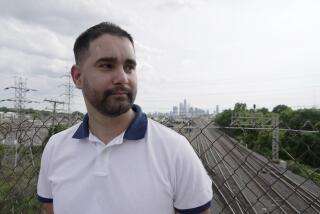Education Urged to Halt AIDS Epidemic : Program Aimed at All, Not Just Gays, Called Only Method Available
- Share via
One after another, a string of health authorities told a public hearing of the Los Angeles City/County AIDS Task Force on Wednesday that an aggressive health education program aimed at the general public--not just the gay population--is the only method now available to halt the AIDS epidemic.
“While public education programs are costly, they are a heck of a lot better than the alternative,” Bruce Decker, chairman of the California AIDS Advisory Committee, said at the meeting at the county Department of Health Services.
Federal, state and county health experts made it clear that they believe the alternative to education programs aimed at both the heterosexual and homosexual populations will be an ever-expanding epidemic.
Effect on County
Mayor Tom Bradley and Board of Supervisors Chairman Ed Edelman had called for the hearing to learn the future effect of AIDS (acquired immune deficiency syndrome) on Los Angeles County, where 861 cases have been reported.
“There is no question but that it is in an epidemic stage. The numbers are frightening,” Bradley said.
Bradley said many resources, both public and private, need to be brought together to attack the problem--health and human services, education programs and community organizations.
No specific proposals for education programs were offered at the hearing. But in San Francisco, former health director Dr. Mervyn Silverman said, public health officials and the gay community have financed hundreds of meetings, distributed 500,000 pieces of literature, placed signs in 400 buses, arranged for public service announcements on radio and television and organized clinics, psychosocial, home care and nursing services.
Other speakers indicated that medical means of curing or preventing AIDS cannot yet be counted upon to solve the problem.
Cure Years Away
Declaring that drugs that will cure AIDS or a vaccine to prevent it are “years away from widespread use,” Dr. Thomas C. Quinn of the National Institutes of Health said the cases reported in Los Angeles to date will double within the next year and “that’s only the tip of the iceberg.”
Of the 10,000 cases reported to date nationally, the mortality rate two years after diagnosis is 95% to 99%, Quinn said.
Other experts at the federal Centers for Disease Control and the National Cancer Institute believe that 300,000 Americans already are infected by the virus that causes AIDS, and that if the present rate of spread continues, 1 million will be infected within the next two years. They estimate that about 10%, or 100,000 of those infected, will develop AIDS.
“If the present percentage continues, 5,000 of the 100,000 will be heterosexuals with no known risk factors,” a report prepared by the Los Angeles City/County AIDS Task Force said.
“This will include both females and increased numbers of mother-fetal transmissions. Los Angeles County will undoubtedly be affected by this dramatic rise, although predictions of specific numbers are difficult.”
Heterosexual Infection
One reason for the growing concern over the spread of AIDS to heterosexuals is a recent report from a New York City venereal disease clinic saying that 3% of the heterosexual males going there had been infected by the AIDS virus.
The AIDS virus can be latent in an individual for five years without the person, male or female, being aware of infection. This means that an individual can infect other people without either party knowing it until symptoms appear years later. The virus is spread by sexual contact or transmission through blood transfusions or contaminated needles used for injecting drugs intravenously.
It is partly because of the virus’ long latency period that the health authorities said it is essential that education and information programs be implemented as quickly as possible.
Different individuals are at risk of developing AIDS by different modes of transmission of the virus, although health officials have warned that the risk is directly proportional to the number of sexual partners--either homosexual or heterosexual--a person has, or whether the person shares contaminated needles.
Different Strategies
The task force report said the varying ways of acquiring AIDS means that different prevention strategies must be prepared for each type of at-risk population--sexually active heterosexuals or pregnant women who may have been infected by the virus and pass it to their babies, for example.
“Ninety-five percent of the cases in Los Angeles continue to be gay males, but in time I expect to see the numbers shift,” Dr. Martin Finn, the county’s medical director for public health said. He said the New York venereal disease clinic’s experience “should cause us to look at AIDS as a disease of the general population.”
Finn said that the cost of medical care for AIDS patients at county hospitals will rise from $3.8 million during the current fiscal year to $8.8 million next year.
“AIDS is not a static illness. It is a growing public health emergency,” he said.
Declaring that preventive programs can save money, Dr. James Chin, chief of infectious diseases for the state Department of Health Services, estimated that the prevention of 12 cases results in a savings of $500,000 to $1 million.
Last year, he said, Los Angeles County spent $128,000 for information and education programs.
More to Read
Sign up for Essential California
The most important California stories and recommendations in your inbox every morning.
You may occasionally receive promotional content from the Los Angeles Times.










